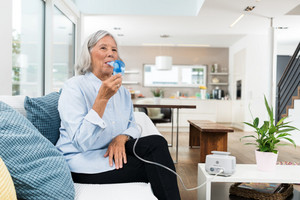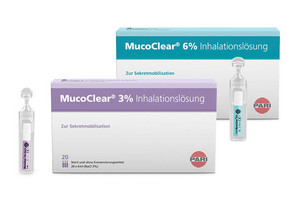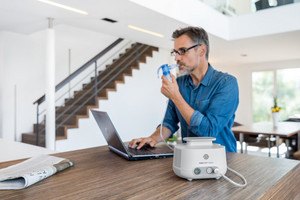
Modified Autogenic Drainage (MAD) is a breathing technique to dislodge mucus from the bronchial tubes and to make it easier to cough up. Many people with chronically mucus-filled lungs – as is the case in cystic fibrosis, chronic bronchitis, COPD or primary ciliary dyskinesia (PCD) – or those who have recently had a lung infection use drainage as part of their breathing therapy.
These patients often need a nebuliser inhalation session before their modified autogenic drainage.
Breathing therapy is a time-consuming exercise, but nebuliser inhalation therapy and modified autogenic drainage work well together. Besides speeding up the therapy, this also makes it more effective. The cleansing effect on the lung is just as good, if not better, and the secretions are easier to cough up with less effort.
You can combine nebuliser therapy with modified autogenic drainage, no matter which device you are using, be it a PARI BOY, an eflow®rapid nebuliser or any other electronic inhalation device.
Add the inhalation solution.
The position should be comfortable and your upper body should ideally be upright. Rest against something.
As you breathe in, your bronchial tubes are dilated. The deeper the mucus in the bronchial tubes, the deeper you have to breathe in.
This gives the air and the droplets of inhalation solution time to spread deep into the dilated bronchial tubes. If you inhale a hypertonic saline solution such as MucoClear 3% or MucoClear 6%, even more mucus is cleared, as the high salt concentration in the solution helps thin the mucus.



When you inhale, the mucus is liquified by the hypertonic saline solution. When you exhale, the airflow makes it easier to dislodge the mucus from the bronchial walls and then to transport it out of the bronchial tubes to the trachea. The mucus can be transported away by clearing your throat, huffing or gentle coughing.
Repeat the process from step 3 for the entire inhalation session. The mucus will not generally shift after the first few breaths, but takes time. The deeper it is in the bronchial tubes or the thicker it is, the longer it takes to transport it up towards the mouth.
This article was written in cooperation with the experienced physiotherapist and respiratory therapist Rita Kieselmann, who has been working in this field since 1974. Her focus is on the treatment of children and adults with chronic respiratory diseases.
Rita Kieselmann is the founder of the Physiotherapy working group in the Mukoviszidose e. V. (Cystic Fibrosis Association in Germany). She has also developed self-help techniques for clearing mucus such as modified autogenic drainage and others.
Note: The information in this blog post is not a treatment recommendation. The needs of patients vary greatly from person to person. The treatment approaches presented should be viewed only as examples. PARI recommends that patients always consult with their physician or physiotherapist first.
An article written by the PARI BLOG editorial team.
© 2025 PARI GmbH Spezialisten für effektive Inhalation